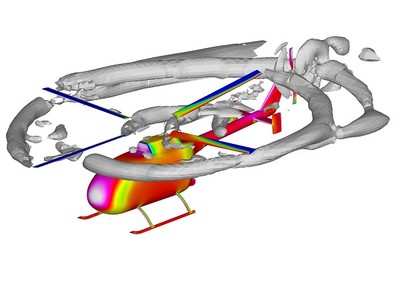Tue, Apr 12, 2011
German And U.S. Agencies Team Up For Advanced Rotor
Research
A helicopter relies on its rotor to be able to take off and land
vertically. The rotor is also responsible for the noise a
helicopter makes during flight. Researchers at the German Aerospace
Center (Deutsches Zentrum fur Luft- und Raumfahrt; DLR) in
Gottingen and NASA are investigating the exact origin of this rotor
noise. The aim is to make the helicopters of the future
quieter.

The collaboration between NASA and the DLR is the subject of a
bilateral agreement. "Our speciality at DLR Gottingen is optical
measurement technology for fluid flows," says Markus Raffel, head
of the helicopter department at the DLR site in Gottingen. NASA
scientist James T. Heineck confirms: "The team at Gottingen is
among the best in the world." NASA researchers are contributing the
most up-to-date measurement technology and their experience with
experiments in the largest wind tunnel in the world.
"Almost everything you hear from a helicopter is aerodynamic
noise. A large part of this comes from what are called rotor tip
vortices," says Raffel. Blade tip vortices occur at the outer end
of the rotor blade. "Reduced pressure on the top of the blade draws
air upwards producing a vortex. The blade tip vortex is then
directed downwards," explains DLR researcher Karen Mulleners, who
is carrying out the tests in collaboration with NASA colleagues.
"When other rotor blades subsequently come into contact with these
vortices, the 'chopping' or throbbing noise that is characteristic
of helicopters is produced."

The researchers are using a test stand with a rotor model from
RWTH Aachen for their investigations. They are using seven
high-speed cameras, lasers and high-powered LEDs to make the vortex
visible. "The special thing here is the simultaneous use of three
different optical measurement techniques," explains Raffel. The
density and the velocity fields in the vortices and the deformation
of the rotor blades are recorded. As in medicine, multiple
investigative methods help reach the correct diagnosis. Thanks to
the latest high-speed cameras, filming at speeds of up to 4000
frames per second is possible. This enables the turbulent,
constantly changing vortex to be observed continuously for the
first time. Until now, the time resolution of cameras has only been
sufficient to capture snapshots.
The rotor tip vortices are also responsible for another problem;
when they touch the ground during take-off or landing, dust or snow
can be swirled up. This can put the pilot in danger as he faces
what is known as a 'brownout' - a complete loss of orientation.
The current measurements will form the basis for future tests in
a wind tunnel. Research using a real helicopter is planned for the
future.
More News
Airplane Bounced About 3 Ft Then Touched Back Down And Then, With No Brakes Applied, The Airplane Began Veering To The Left Analysis: The pilot entered the airport traffic pattern >[...]
Aero Linx: British Microlight Aircraft Association (BMAA) The primary focus within all aviation activity is SAFETY. In all aspects of our sport SAFETY must come first, whether it b>[...]
From SnF25 (YouTube Edition): William Wynne Builds Practical Aircraft Engines on the Corvair Platform Seeking an affordable alternative to the traditional aircraft engine options, >[...]
How To Get A Story On Aero-TV News/Feature Programming How do I submit a story idea or lead to Aero-TV? If you would like to submit a story idea or lead, please contact Jim Campbel>[...]
From 2023 (YouTube Edition): Bridge of CiES CiES Inc. is a Bend, Oregon-based designer and manufacturer of modular embedded aircraft systems and sensors. The company’s fuel-l>[...]
 NTSB Final Report: Aviat A1
NTSB Final Report: Aviat A1 ANN's Daily Aero-Linx (07.08.25)
ANN's Daily Aero-Linx (07.08.25) Classic Aero-TV: Fly Corvairs Reliable Engine Alternative
Classic Aero-TV: Fly Corvairs Reliable Engine Alternative ANN FAQ: Contributing To Aero-TV
ANN FAQ: Contributing To Aero-TV Classic Aero-TV: CiES Fuel-Quantity and e-Throttle Systems Praised
Classic Aero-TV: CiES Fuel-Quantity and e-Throttle Systems Praised




